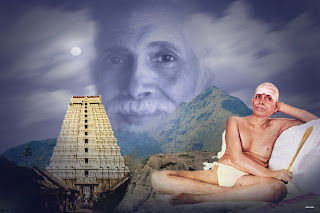காரைக்காலுக்கு அருகே உள்ள ஊர் தில்லையாடி. அங்கே, அலங்காரத்தம்மாள் என்பவர் தன் மகனோடும் மருமகளோடும் வசித்து வந்தார். அங்கே உள்ள முதிய துறவி ஒருவருக்குத் தொண்டு செய்து கொண்டிருந்தார். அந்தத் துறவிக்கு இறுதிக் காலம் வந்தது. 'உங்களுக்குப் பிறகு எங்கள் கதி என்ன?’ என்று கவலையுடன் அவர்கள் மூவரும் கேட்க, ''என்னிலும் ஞானமான முனிவர், திருவண்ணாமலையில் வசிக்கிறார். பாலசுவாமி என்று அவரை அழைப்பார்கள். அவரிடம் போய் சேவை செய்யுங்கள். அந்த பாக்கியம் உங்களை முக்தி நிலைக்கு அழைத்துப் போகும்'' என்றார்.
அந்தத் துறவி சமாதியானதும், அலங்காரத்தம்மாள் மகன் சுப்பையா மற்றும் மருமகளுடன் திருவண்ணாமலைக்கு வந்தார். பாலசுவாமியைத் தரிசித்தார். உள்ளே ஆனந்தம் பொங்கியது. திரும்பக் காரைக்காலுக்கு வந்து, தன் சொத்துக்களை வேறு ஒருவரிடம் ஒப்படைத்து, அவர் தந்த பணத்துடன் திருவண்ணாமலைக்கு வந்து, வாடகை வீட்டில் தங்கி, தினமும் பாலசுவாமியைத் தரிசித்து வந்தார். அலங்காரத்தம்மாள் உணவு தயாரித்து பாலசுவாமிக்கு எடுத்துப் போவார். அதே நேரம், எச்சம்மாளும்உணவு எடுத்து வந்தார். அன்பர்கள் வருகையால், இருவர் உணவும் அங்கே தேவையாக இருந்தது. காரைக்காலில் இருந்து வரும் தொகை, வர வர குறைந்து போயிற்று. நித்தியப் படி குடும்பம் நடத்துவதே சிரமமாக இருந்தது. சுப்பையா திடீரென திருப்பனந்தாள் மடத்துக்குப் போய் சந்நியாசம் வாங்கி, துறவியாகி, ஊர்ஊராகச் சுற்றி வந்தார். இதையடுத்து, அலங்காரத்தம்மாளும் அவர் மருமகளும் நல்லெண்ணெய், அப்பளம் விற்று, அந்தப் பணத்தில் பாலசுவாமிக்கு உணவு அளித்து வந்தனர். உத்தமமான ஒரு ஞானியை, ஒருவணிகர் குடும்பத்துப் பெண்மணியாய் இருந்து சரணடைந்தார். என்ன நேரிடினும் கவலையற்று, அவர் சேவையே முக்கியம் என வாழ்ந்தார். வறுமை காரணமாக இடம் மாறி, மடத்துக்குப் போய் துறவறம் பூணுகிற பொய்மையை அவர் விரும்பவில்லை. 'தன்னை வருத்திக்கொண்டு குரு எவ்வளவு எளிமையாக வாழ்கிறார். அவரைவிட எளிமையாக வாழ்வதல்லவா சிறப்பு!’ என்று அவருக்குத் தெரிந்திருந்தது.
எத்தனைக் கஷ்டம் வந்த போதும், பாலசுவாமிக்கு உணவு தருவதை நிறுத்தவே இல்லை. உணவை பெரிய உருண்டையாக்கி, அலங்காரத்தம்மாள் பாலசுவாமியின் கைகளில் போடுவாள். ''பாட்டி, நீங்கள் தரும் சோற்று உருண்டை, வர வர பெரிதாகிக்கொண்டே போகிறது'' என்று சுவாமி சொல்ல, ''பெரிசு, சிறுசு எல்லாம் நம் மனதில்தான் இருக்கிறது'' என்று அலங்காரத்தம்மாள் சொன்னார். ''அடடா, நான் சொல்லிக் கொடுத்ததையே பாட்டி, என்னிடம் திருப்பிப் போடுகிறார்'' என்று பாலசுவாமி சிரித்தபடியே, அவரைக் கொண்டாடி இருக்கிறார்.
மலைக்கு கீழே ஆஸ்ரமம் உருவான நேரம். அலங்காரத்தம்மாளுக்கு உணவு தருவதில் மீண்டும் கஷ்டம் ஏற்பட்டது. தள்ளாமை அதிகரித்தது. ''எதற்கு சிரமம்? பாலசுவாமியை ஆஸ்ரமம் பார்த்துக்கொள்ளும். உங்களை..?'' என்று பலர் சொல்ல, ''என் கடைசிக் காலம் வரை அவருக்கு உணவு தரும் சேவையைச் செய்வதே என் வேலை. காசு இல்லாவிட்டால் என்ன, உடம்பு தள்ளாடினால் என்ன, தடி ஊன்றி நடந்து, பிச்சை எடுத்து உணவு சேகரிப்பேன்'' எனச் சூளுரைத்தாள் அலங்காரத்தம்மாள்.
பாலசுவாமிக்கு ஆஸ்ரமத்தில் உணவு பரிமாறும் போது, அலங்காரத்தம்மாளின் உணவில் சிறிது அவருக்கு வைக்கப்படும். ஆனால், அன்று வைக்கப்பட வில்லை. சுவாமி அந்த உணவைச் சாப்பிடவில்லை. 'ஏன்? என்ன?’ என்று பதறி யோசித்தபோது, அலங்காரத்தம்மாள் கொண்டு வந்த உணவு வைக்கப் படாதது தெரிந்து, உடனே வைக்கப்பட்டது. பிறகு, சுவாமி மௌனமாக அந்த உணவை ஏற்றார். இதைவிட உத்தமமான மரியாதை, அந்த சிஷ்யைக்கு வேறு என்ன இருக்கக்கூடும்!
குருவுக்கும் சிஷ்யைக்கும் உண்டான உணர்வு பூர்வமான உறவு, அங்கே வெகு கெட்டியாக இருந்திருக்கிறது. தன்னைச் சரணடைந்தவர்களைச் சுவாமி கைவிட்டதே இல்லை. ஆடம்பரம் சிறிதும் இல்லாத வாழ்க்கையைத் தானும் வாழ்ந்து, தன்னை அண்டியவருக்கும் அதனை அருளியிருக்கிறார். அவரின் அடியவர்களும் இதனை உணர்ந்து, எளிமையின் இருப்பிடமாக வாழ்ந்திருக் கின்றனர். இப்போது இந்த விஷயத்தை யோசித்தால், வியப்பிலும் வியப்பாக இருக்கிறது.
ஒருநாள், பாலசுவாமி விருபாக்ஷி குகையிலிருந்து கீழே இறங்கி, மலையைச் சுற்றத் துவங்கினார். பிறகு, குறுக்கு வழியாக விருபாக்ஷி குகைக்கு ஏற ஆரம்பித்தார்.
அது அடர்ந்த வனப் பகுதி. மனித நடமாட் டமே இல்லாத இடம். விருபாக்ஷி குகை எங்கு இருக்கிறது என்று அடிக்கடி மேலே பார்த்து, நிதானித்து நடக்கவேண்டிய நிலை. அப்போது, பெரிய ஆல இலை ஒன்று காற்றில் பறந்து வந்து, அவர் மேல் விழுந்தது. பொதுவாக, ஆல இலை, உள்ளங்கை அகலமிருக்கும். அதிகபட்சம் இரண்டு உள்ளங்கை அகலமிருக்கும். இந்த ஆல இலையோ, பல இலைகள் வைத்துத் தைத்த பெரிய தையல் இலை போல் இருந்தது. அதைப் பார்த்ததும், அண்ணாமலையார், அருணகிரி யோகி எனும் சித்தர் வடிவில், ஆல மரத்தின் கீழ் அமர்ந்திருக்கிறார் என சொல்லும் வடமொழிப் பாடல் ஞாபகம் வந்தது. அப்படியெனில், அந்த ஆலமரம் அருகேதான் இருக்க வேண்டுமோ என நினைத்து, அதைத் தேடி, மலைமீது ஏறினார். தரையில் விழாது, காற்றில் மிதந்து, ஆல இலை வந்திருக்கிறது எனில், அந்த ஆலமரம் மிக அருகில்தானே இருக்கவேண்டும்! அந்த அருணகிரியோகி என்ற சித்த புருஷர் அங்கேதான் இருக்கவேண்டும். காணப் போகிறோமா, கண்டுபிடித்துவிட்டோமா என ஆவலுடன் வேகமாக மலையேறினார் பாலசுவாமி. அப்போது, அவரது இடது கால், அங்கே ஒரு புதரின் உள்ளே இருந்த தேன்கூட்டை இடித்துச் சிதைத்தது.
இதைக்கண்டு வருத்தப்பட்டார் சுவாமி. இவற்றுக்கு ஊறு செய்துவிட்டோமே என வேதனைப்பட்டார். தேனீக்கள் எகிறிப் பறந்தன. வட்டமடித்தன. எந்தக் கால் இடித்ததோ, அந்தக் காலை நோக்கி முட்டிமோதிக் கொட்டின. வேறு எந்த மனிதராக இருப்பினும் உதறி, அந்த இடம் விட்டு விலகி ஓடியிருப்பார்கள். தேனீக்கள் துரத்தும்போது, துணியை விசிறியடித்துக் கொன்றிருப்பார்கள். 'நான் வேணும்னு செய்யலையே! தெரியாமல்தானே கால் பட்டுடுத்து!’ என்று சமாதானம் சொல்லியிருப் பார்கள். இரண்டு கொட்டுக்கள் வாங்கியதும் சீறி, 'என்னையா கொட்டினாய்! உன் குலத்தையே நாசம் செய்கிறேன் பார்’ என்று தீயிட்டு, மொத்தத் தேன் கூட்டையும் பொசுக்கியிருப்பார்கள்.
ஆனால், சுவாமி அப்படியெல்லாம் செய்ய வில்லை. 'தவறு என்னுடையது. தெரியாமல் செய்தாலும், தவறு தவறுதான். அவை வசிக்கும் இடத்தை, தேன்கூட்டைச் சிதைத்துவிட்டேன். அங்கு எவ்வளவு நட்டம் ஏற்பட்டது என்று யாருக்குத் தெரியும். அவற்றுக்கு எத்தனை வேதனை என்று யார் அறிவார். அவை கோபமுற்றுக் கடிக்க வருகின்றன. வெறுமே நடந்தபோது துரத்தவில்லையே, இடித்ததால்தானே கோபம் கொண்டன! தருமத்தோடுதான் அவை நடந்து கொண்டிருக்கின்றன.
நான் மட்டும் எப்படி ஓடி ஒளிவது? செய்த தப்பிலிருந்து எப்படித் தப்பிப்பது? உங்கள் கோபம் சரியானதுதான். கொட்டுங்கள்; கோபம் தீரும் வரை கொட்டுங்கள்!’ என்று அசையாது, அங்கேயே நின்றிருக்க, வலது காலைத் தொடாது, கூட்டை இடித்த இடது காலில் தேனீக்கள் கொட்டித் தீர்த்தன.
பிறகு, ஒரு தேனீயும் சுற்றவில்லை என்று தெரிந்ததும், பாலசுவாமி மெள்ள நடந்தார். சரியான வலி; கடுக்கின்ற வேதனை; ஊசி நுனியில் உள்ள விஷத்தால், உள்தசையில் தீயிட்டுப் பொசுக்குவது போன்ற வலி. ஆல மரமும், அதன் கீழே இருந்த சித்த புருஷரும், பறந்து வந்து மேலே மோதிய ஆல இலையும் மறந்து விட்டன. திசைமாறி, முலைப்பால் தீர்த்தத்துக்கு அருகேயுள்ள ஜடைசுவாமி குகைக்குப் போனார் சுவாமி. அங்கே அவருக்குப் பாலும் பழமும் கொடுக்கப்பட்டது. கொஞ்சம் ஆசுவாசப்படுத்திக் கொண்டு, மறுபடியும் விருபாக்ஷி குகைக்கு வந்தார். தொடை மேலும் வீங்கிவிட்டது. நகர்த்த முடியாதபடி கடும் வேதனை ஏற்பட்டது. இதனை எவரும் கவனிக்கவில்லை.
ஆனால், வீக்கத்தைக் கண்டு தொண்டரான பழனிச்சாமி கலங்கிப்போனார். 'இது என்ன’ என்று பதறிக் கேட்க, விவரித்தார் சுவாமி. மறுநாள், நல்லெண்ணெய் வாங்கி வந்து, தொடையில் தடவ, உள்ளுக்குள்ளே கொடுக்குகள் சிக்கியிருப்பதை விரல்களால் உணர்ந்து, அவற்றை அப்புறப்படுத்தினார் பழனிச்சாமி. அடுத்த இரண்டு மூன்று நாட்களில் வீக்கம் வடிந்து விட்டது.
'தற்செயலாய் நேர்ந்த விஷயம்தானே! இதற்காக, தேனீக்களின் கடியை யாராவது வாங்குவார்களா! ஏதோ வேண்டுமென்றே செய்ததைப் போல, ஏன் தண்டனையைப் பெறவேண்டும்?’ என்று பாலசுவாமியின் அன்பரான முருகனார் என்பவர் ஒரு கவிதையில் வினவ, அதற்குப் பாலசுவாமி கவிதையாய் பதில் சொன்னது உண்டு.
'பச்சையிலை துறு படர்ந்தபுத ரென்றெண்ணி
வைச்சிடுகால் வீங்க வரிக்க தண்டு கொட்டலுமே
நிச்சயமாய் வேங்கட நின் னெஞ்சொப்பி செய்தாற்போல
தற்செயலாய் நேர்ந்த தவற்றுக் கிரங்க லென்னே’
- என்று அந்த அன்பர் கேட்க, பகவான் அதேவிதமாகக் கவிதை நடையில் பதில் சொன்னார்.
'பச்சையிலைகட் படர்ந்தங் கூடுலைய
வைச்சிடு கால் வீங்க வரிக்கதண்டு கொட்டிடினும்
தற்செயலாய் நேர்ந்த தவறேனுந் தானிரங்கும்
அச்செயலு மின்றே லவன்மனதின் தன்மையென்ன’
இது தற்செயலாய் நேர்ந்ததுதான். ஆனாலும், தவறு தானே; தண்டனை உண்டுதானே? அதை ஏற்க மறுத்து ஓடி ஒளிந்தால், அது என்ன தன்மை? (அது நியாயம்தானா?).
தண்டனையில் இருந்து தப்பித்துக் கொள்வதுதான் மனிதர்களின் இயல்பு. தண்டித்தவரையே தண்டிப்பது தான் பழக்கம். இந்த ஞானி, உலகில் எல்லா உயிரினங்களோடும் ஒரேவிதமான பார்வையை, ஒரேவிதமான உறவைக் கொண்டு இருக்கிறார். தேனீக்கள் அற்பமானவை அல்ல; அவற்றின் வாழ்விடம் சாதாரணமானதல்ல. தெரியாமல் ஊறு விளைவித் திருந்தாலும், அவற்றின் கோபத்தை ஏற்று, தண்டனையை வாங்கிக்கொள்வதே சரி!
ஞானத்தின் உச்சகட்டம் பாலசுவாமி என்று உணரும் போது, நம் உடம்பு சிலிர்க்கிறது; கிடுகிடுக்கிறது.
வடவாலம் என்று சொல்லப்படுகிற அருணகிரிசித்தர் வாழ்கின்ற அந்த இடத்தை மறக்கடிக்கத்தான் ஒருவேளை இந்தச் சம்பவம் நிகழ்ந்ததா? பிற்பாடு வெகுநாள் கழித்து, 'அப்படியில்லை’ என்று பகவான் ஸ்ரீரமணர் மறுத்திருக்கிறார்.
''ஒரு பாறை மீது பெரிய ஆலமரம் இருந்தது. அதை அருகில் பார்ப்பதற்காக, ஒரு சிற்றோடையைக் கடந்து, மறுபக்கம் போக விரும்பினேன். அதற்குள் தேனீக் கூட்டைக் கலைத்துவிட்டேன். ஆலமரம் போகிற எண்ணம் மறந்துவிட்டது. அவ்வளவே!'' என்று சொல்லியிருக்கிறார்.
ஆலமர அதிசயம் இங்கு முக்கியமில்லை. சகல உயிர்களையும் மதித்தல் என்பதே இங்கு சொல்லப்படுகிற விஷயம். எந்த உயிருக்கும் தீங்கிழைக்காத அஹிம்சைத் தன்மையே இங்கு முக்கியம். இந்த வலியை நாலு பேரிடம் சொல்லி, பரிதாபம் தேட முயற்சிக்கவில்லை சுவாமி. கண்டுபிடிக்கப்பட்டபோதும், இது இது நடந்தது என்று சாதாரணமாகச் சொல்கிறார்.
பகவான் ஸ்ரீ ரமண மகரிஷியின் ஒவ்வொரு செயலும் பொருள் பொதிந்தவை; தர்மம் சார்ந்தவை!


























